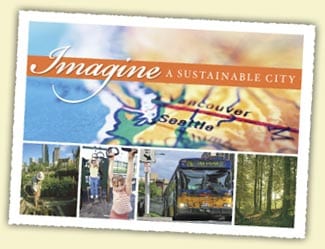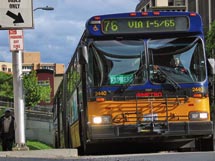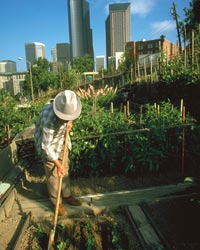Imagine a sustainable city
by Chantal Stevens
This article was originally published in January 2006

(January 2006) — When considering the ability of our planet to sustain itself over the next generations, cities are increasingly viewed as the decisive element. More people currently are living in cities than lived on the whole earth circa 1955.
There are more cities and they are getting larger. Worldwide, cities are the largest importers of products and resources and the largest exporters of waste and pollution. Yet Dora Bakoyannis, mayor of Athens, Greece, recently was quoted as saying, “The leaders in the future of environmental protection will be the world’s great cities.”
She believes cities can lead the way because it’s much easier for citizens to work at the local, rather than national level. She and other leaders see a network of great progressive cities learning from one another and coordinating efforts to get things done, as when the mayors of major U.S. cities recently agreed to meet the climate protection emission goals of the Kyoto Treaty even though the U.S. government has not ratified the accord.
Cities are environmentally efficient
Urban residents in fully developed countries like the United States do not consume more than their rural counterparts. But because they live under highly concentrated conditions, they have a more staggering impact on the environment.
Mathis Wackernagel, co-inventor of the “ecological footprint,” estimates the ecological footprint of the average American to be 24 acres. This is the amount of land required to produce the food, fuel and fiber to sustain our present high-consumption lifestyle.
Sustainability is defined by the 1987 Brundtland Report as being able to meet the needs of the present generation without compromising the ability of the future generations to meet their needs. It can be achieved by having individuals minimize their consumption patterns so they can be mostly supported by the local economy.
Washingtonians, for example, would need to reduce our collective ecological footprint almost by half so all 3.1 million residents could live sustainably within the land area of the state. Currently, the population of Washington cannot sustain its current lifestyle without a heavy import of resources from elsewhere and a strong dependence on land outside its boundaries.
Concentration of humans in urban centers is a necessity. If each family in King County lived on a fenced acre, there would be no land left for farmland, open space or wilderness. No place to hike, nowhere for bear to roam, no old growth forests, no food production beyond backyard gardens.
It is because so many residents live on 5,000 square-foot urban lots or in 1,000 square-foot apartments that almost half of King County remains covered with forests despite being home to more than 1.7 million people.
Concentration is desirable. It creates many opportunities that William Reese of the University of British Columbia calls the Urban Sustainability Multiplier.
These opportunities include reduced per capita demand for occupied land; lower costs per capita of providing water, sewer and most other types of infrastructure and amenities; a greater range of options for recycling, reuse, re-manufacturing, and a concentration of skills needed to make these things happen; greater possibilities for electricity co-generation and the use of waste process heat from industry or power plants to reduce the per capita use of fossil fuels; and great potential for reducing energy consumption by motor vehicles through walking, cycling and public transit.
Reliance on alternative means of transportation reduces fuel consumption and related pollution. Currently, almost 70 percent of King County residents who commute to work drive alone.

In Copenhagen, a city roughly similar in size as Seattle, one third of the commuters drive, one third take public transportation and one-third walk or bike. As a result, Copenhagen during rush hour often feels like Seattle on a Sunday morning. On-road vehicles are a leading contributor of air pollution. Congestion contributes to economic losses for the region, stress and decreased free time for all.
A sewer system that handles the wastes of a million people is more efficient and easier to control than one quarter million individual septic tanks. That large-scale sewer system could even be turned into an asset for the environment under the right conditions and leadership.
In Arcata, Calif., for example, a constructed wetland treats the wastewater for 15,000 residents while enhancing the biological productivity of the environment into which treated wastewater is discharged. It provides a home or rest stop to 200 species of birds.
Co-generation, or combined heat and power, is possible when electricity-producing power plants and dense residential or industrial areas are in close proximity. The heat that usually is wasted as a by-product of electrical generation is captured and distributed via hot water pipes to homes and offices, where it provides heat for hot water and space heating.
According to Jayson Antonoff, a Seattle-based sustainable energy planner and engineer, electricity co-generation has greatly increased the efficiency of energy systems in many parts of Northern Europe. In cities such as Copenhagen, more than 98 percent of the homes are heated this way, so that houses and apartments no longer need hot water heaters, furnaces or baseboard heaters. As a result, fuel consumption is decreased, as is the corresponding production of greenhouse gases.
Agriculturally-based communities
Over the last century, the rise of urbanization throughout the world has intensified the disconnect between production and consumption. This is particularly true for food. While cows used to be raised in the farms outside the city and butchered locally to be sold at local meat shops, livestock nowadays will travel thousands of miles in its different forms before reaching the average consumer’s plate.
When dealing with live animals, the issues range from wasted energy, the practice of exploiting regions with laxer environmental regulations and lower pay rates for workers, to ethical implications. Should chickens be trucked, overcrowded and stressed, in unheated bare cages across the country?

When integrated, cities and agriculture complement each other. Cities offer a reliable market for farm products while sustainably managed agricultural land can help absorb carbon dioxide, filter water to aquifers, and serve as habitat for fish, birds and wildlife. Creating incentives and opportunities for local agriculture to flourish supports the local economy and social stability.
The large-scale network that handles food creates a movement of products throughout the world that displaces large quantities of resources, energy and nutrients from region to region in an unsustainable manner.
Sustainability is about fairness, but under this unsustainable lifestyle the burden of providing us with food, energy and other products, receiving and treating our waste, and supporting the impact of our consumerism is shifted to other regions such as developing countries with regulatory mechanisms less protective of environmental and social structures. It also borrows from the future, since we are taking natural and other resources and are not replenishing them as we go.
How we spend our money goes a long way in affecting where farms are located, the type of farms needed, and how much energy and waste will be generated. A 1997 study in Maryland found that the average pound of produce traveled more than 1,685 miles and the average distance for fruits to be transported was 2,146 miles. Trade-related transportation has been estimated to account for one eighth of world oil consumption.
The typical American diet requires the staggering equivalent of 400 gallons of oil each year. A 2001 Iowa State University study showed that when produce was distributed by a local cooperating network of farmers directly to local retailers, four to 17 times less fuel was used and five to 17 times less carbon monoxide was released than when the produce was distributed through national chains to supply the local economy.
The same study estimated that when only 10 percent more of the produce for local consumption in Iowa was grown and transported using the local network of farmers, 280,000 to 346,000 gallons of fuel were saved annually.
Sustainability involves balancing economic development, social equity and environmental protection. When we reduce our ecological footprint by making our consumption more local, the environment is not the only beneficiary.
Studies have shown that dollars spent locally tend to stay far longer in the economy than dollars spent elsewhere. Northumberland County in England. studied how using local supplies could shift the impact on the region of its $420 million procurement budget. Local suppliers respent on average 76 percent of their contract with local people and businesses, while suppliers based outside the county respent on average 36 percent of their contract locally.
By shifting just 10 percent of their spending from non-local to local suppliers, they would generate an additional $58 million to the local economy.
Viki Sonntag, who is leading a study to calculate the economic and sustainable benefits of localizing the food economy for Sustainable Seattle, believes that “by spending our dollars locally, we not only are strengthening our local economy but also are making an investment in our social capital.” Social capital is the sum of all the institutions, people and relationships that provide the glue holding a society together.

“Local economic linkages create trust and the capacity to innovate in response to local social and environmental needs,” says Sonntag. “Localizing the economy also is about refocusing economic development from attracting dollars into the region to how well we use those dollars once they’re here. The local multiplier as an indicator gets us to go beyond thinking about how much things cost to who benefits.”
Dr. Sonntag is confident that the local multiplier will make the economic case for investing in the development of sustainable local economies and that it will become an influential and useful decision-making tool for economists, urban planners, politicians and consumers.
Sustainability for a city, community or an individual is about living within one’s means and borders; considering the long-term consequences of any decisions; and making sure that our children and their children are not cheated of their social, economic and environmental inheritance.
Any action — whether voting, writing a new policy, purchasing a product, or deciding where to live or how to go to work — should be undertaken as though, to paraphrase John Muir, it was hitched to everything else in the Universe.
Chantal Stevens is executive director of Sustainable Seattle and a member of the PCC Board of Trustees.
